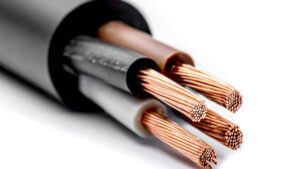Grade not King: Why low-grade copper won’t deter these ASX miners

ASX miners are taking the leap to mine low-grade copper. Picture: Getty Images
Copper is about to change the world, again.
Ever-present – yet benignly invisible to us – current demand comes in the form of not only our staple diets of electrification, lighting and communication (see: 20th century), but as a pillar of humanity’s current movement into our ‘green revolution’.
Copper – once referred to as ‘fool’s gold’ because of its marriage with chalcopyrite – is no fool at all, and will remain a future stalwart commodity as we move into exponential production of batteries, electric vehicles and a plethora of other decarbonisation and electrification advances that require the element.
The idea that copper producers require >1% copper grades to make projects viable is by all means historically accurate, however global requirements for copper now, and into the future have turned that sentiment on its head.
Bridging the gap: What the analysts say
A March UBS copper trends analysis has foreshadowed a limited pick-up in new copper mine approvals and a likely slowdown in mine supply growth in FY 2025-26.
It estimated this year’s global total copper capex was about 15% below the peak of the last cycle in 2012-13, and that is further stretching out foreseen production deficits.
“We estimate project approvals need to lift to US$10bn in 2024 and expand to US$30bn in 2027 with cumulative new project spend of >$100bn by 2027 to deliver 5mt of new mine supply by 2030,” UBS analysts said in the note.
“We expect unidentified small brownfield/life extension projects (likely with lower capital intensity) to fill some of this gap; but, despite the intention to deploy more capital to copper mining, in our view it is clear that capex is not being deployed quickly enough.
“However, in our view recurring supply issues vs resilient demand means the probability of a material surplus in 2023/24 is diminishing and a lack of capex makes the medium-term outlook for copper increasingly compelling.”
McKinsey analysts see the outlook for copper supply by 2031 to be about 30 million tonnes (mt), however, they project demand to hit 36.6mt, which is a considerable gap to fill.
There are already a handful of ASX-listed low-grade explorers and developers excited about the value they can extract from low-grade copper mining.
The lower the better
Porphyry mines are huge, and responsible for ~60% of the world’s copper, most of the molybdenum, and significant amounts of gold and silver. Their large volumes make up for the low grades, typically between 0.2% to 0.7% copper equivalent.
They’re also easy to mine as they’re often shallow in nature.
The Stockhead team spoke with Dr Frazer Tabeart, managing director of budding copper producer Alma Metals (ASX:ALM) to get his take on the fundamentals of low-grade copper production and the company’s own low-grade porphyry deposits at its Briggs, Mannersley and Fig Tree Hill copper project in QLD.
Dr Tabeart sees opportunities for lower-grade deposits that have existing infrastructure, given current market projections.
“The fundamentals for copper, in our view, are very strong, so there is going to be a long-term demand profile which supports the expansion of global copper mining,” Tabeart said.
“Discovery rates of large copper deposits are dropping, and most recent higher-grade discoveries of any significance have been in remote jurisdictions where infrastructure is lacking, and where it’s going to be very expensive to build.
“There’s an opportunity for lower grade deposits that have good quality existing infrastructure because the upfront capital to develop these is far less onerous, and this lowers the project risk making it easier to get finance.”
“We think that copper is going to be a critical mineral for the foreseeable future and we’re placing Alma Metals in a position to be part of that narrative.”
ALM’s main focus will be at Briggs Central, which has a two-year-old inferred mineral resource of 143mt @ 0.29% Cu.
Its ongoing drilling program is targeting exploration ranges of between 455-850mt @ 0.2-0.35% Cu, which excludes the current inferred resource.
ALM recently completed a $2m cap raise for additional core drilling at Briggs to commence early Q3 this year, with the expectation of producing a revised mineral resource estimate not long after.
Meanwhile, Caravel Minerals (ASX:CVV) – also looking at low-grade copper production – has the strength of its 2.84mt copper output at its namesake project, near the town of Wongan Hills in WA’s central wheatbelt.
The $1.67bn Caravel project could well turn out to be one of the largest copper mining operations ever delivered in Australia, as it looks to produce 71,000 tonnes per annum (tpa) over the first five years.
This is comparable to the likes of OZ Minerals’ Prominent Hill and Carrapateena in South Australia and Sandfire’s recently shuttered DeGrussa in WA.
The project contains a low grade of 0.24% copper, lower in comparison to the diet Aussie investors feed on; however, the grade is pretty stock-standard for what the US industry uses.
The company is pushing forward with the finalisation of its definitive feasibility study (DFS) and has eyes on development and production in the near future.
Shuffled out of the same deck is Kincora Copper (ASX:KCC), an active copper-gold explorer in Mongolia, one of the most significant porphyry regions in the world.
Its Brown Fox project in the Southern Gobi copper-gold belt has a maiden inferred mineral resource estimate of 426kt of copper and 437koz of gold to a depth of 325m below surface.
KCC says only relatively limited drilling has been completed at the project to date, and is confident the underexplored three large porphyries at the Brown Fox tenements point to a high-tonnage, low-grade copper-gold mining operation.
More to the point is the extreme leverage Caravel, Alma and Kincora have to copper price moves.
For instance, a US50c increase in the copper price would add well over $1bn to the Caravel project’s net present value (NPV), currently estimated at $2bn.
With copper demand expected to outstrip supply over an extended multi-decade period, it’s no wonder these mining companies can see the upside potential of their low-grade Cu projects.
“At Stockhead, we tell it like it is. While Alma Metals and Caravel Minerals are Stockhead advertisers, they did not sponsor this article.”
Related Topics

UNLOCK INSIGHTS
Discover the untold stories of emerging ASX stocks.
Daily news and expert analysis, it's free to subscribe.
By proceeding, you confirm you understand that we handle personal information in accordance with our Privacy Policy.








